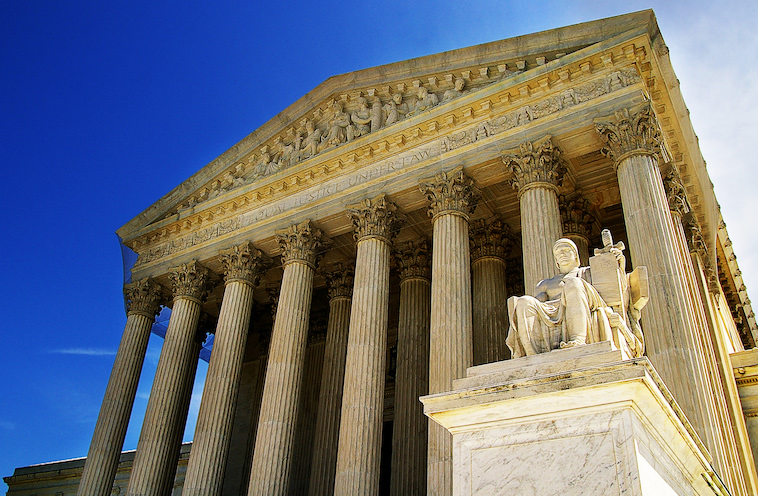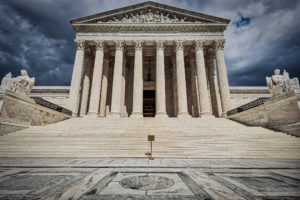
In his initial year on the Supreme Court, Justice Kavanaugh’s performance on the bench appears balanced and deliberate.
The appointment of Brett Kavanaugh to the Supreme Court has provoked acrimony on a scale seldom seen over judicial nominees—and has included, most recently, calls for his impeachment by Democratic presidential candidates. During his nomination hearings in 2018, then-Judge Kavanaugh responded to his critics in a manner that came across as behavior befitting a partisan rather than a neutral jurist, especially as he denounced criticisms leveled against him as nothing more than a “political hit” by the Clintons.
His politicized remarks at his hearing elicited considerable media criticism, mockery from Saturday Night Live, and even a rare condemnation from a retired U.S. Supreme Court Justice, who argued that Justice Kavanaugh’s statements should disqualify him from the court.
But does Justice Kavanaugh’s performance during his first year on the Court correspond to how he conducted himself during his confirmation hearings? For example, some scholars speculate that Justice Thomas’ confirmation experiences contributed to his near-silence during Supreme Court oral arguments. My examination of 58 oral arguments heard since Justice Kavanaugh joined the Court suggests that his conduct on the bench defies the profile of a partisan misogynist.
Oral arguments are an important part of the judicial process. During these public debates, the lawyers present their case, and the justices interrupt to ask questions. Scholars suggest that these lawyer-justice interactions reveal the justices’ opinions and even affect their votes. Furthermore, the justices’ participation offers insights into their personalities.
My analysis, which draws on my coding of transcripts of oral arguments before the Supreme Court, suggests that Justice Kavanaugh shows the same respect to female lawyers as he does to male lawyers. For context, during oral arguments, justices frequently interrupt the lawyers to ask questions and sometimes even make long-winded statements. Because this behavior denies lawyers the chance to make their case, the interruptions could be seen as disrespectful towards lawyers.
Justice Kavanaugh, however, interrupts female and male lawyers with the same frequency. Furthermore, he speaks equally during the presentations of female and male lawyers. In fact, among his colleagues, Justice Kavanaugh displays the least difference in speaking time during the presentations of female versus male lawyers. These findings parallel other recent observations of Justice Kavanaugh’s respectful behavior towards women in his capacity as a member of the Court. For instance, he reportedly hired the first all-female cohort of clerks, even eliciting praise from Justice Ruth Bader Ginsburg.
Observers might say that Justice Kavanaugh is merely living up the expectations of a newly minted justice. Not quite so; Justice Kavanaugh’s participation style is more subdued than that of Justice Neil Gorsuch, another recent appointee.
This is an interesting finding, considering the two justices’ similarities: President Trump appointed them both, and they even attended the same preparatory school. Justice Kavanaugh’s first oral argument, Stokeling v. U.S., set the tone for the rest of the term. In Stokeling, he spoke only six times, talking for just 3.6 percent of the debate. Even when he did speak, his statements were reportedly subdued compared to those of his colleagues.
By contrast, Justice Gorsuch, during the first Supreme Court oral argument he participated in, reportedly asked 22 questions and spoke for 7.2 percent of the time. Indeed, during that oral argument, Justice Gorsuch was the second most talkative justice after Justice Elena Kagan. Furthermore, Justice Gorsuch’s statements were notably aggressive.
More broadly, since Justice Kavanaugh joined the Court, he has spoken for an average of 3.5 percent of the time during oral arguments. Over this same period, Justice Gorsuch spoke for an average of 4.1 percent of the time. Furthermore, when Justice Kavanaugh did interject, he said fewer words on average than Justice Gorsuch, making him either quieter or more concise than his colleague. In fact, among the eight justices who regularly participate in oral argument (Justice Thomas very rarely does), Justice Kavanaugh was one of the least vocal. His speaking time also varied the least, making him the most consistent in his quietness.
Finally, Justice Kavanaugh has not come across as a rigid partisan. He appears interested in persuading others to vote with him. For context, justices use oral arguments to persuade their colleagues. To accomplish this, scholars suggest that “hostile questions to a lawyer…are more effective than softball questions pitched to the side the Justice favors.”
Following this logic, I compared how long the justices talk during the presentations of lawyers with whom they agree to those with whom they disagree, with agreement or disagreement determined by the justices’ ultimate votes in each case. To illustrate, Justice Antonin Scalia— who was famous for his go-it-alone style—apportioned his time about equally between the lawyers whose sides he voted for and against. His time apportionment was relatively balanced compared to that of his colleagues.
Justice Kavanaugh, however, spent twice as much time critiquing lawyers he disagreed with as he did supporting lawyers with whom he agreed. In fact, Justice Kavanaugh’s style has so far been moderately more skewed towards persuasion than any of his colleagues’ currently on the Court.
Furthermore, of the eight justices who regularly speak during oral arguments, Justice Kavanaugh’s time apportionment varied the least between cases, making him the most consistent in terms of this indicator of persuasive behavior. Other scholars have observed a similar desire from Justice Kavanaugh to accommodate others’ perspectives. For instance, Kavanaugh cites moderate liberals more than originalists during oral argument, and he is reportedly more often in the majority than his colleagues.
During oral arguments, Justice Kavanaugh’s judicial persona has so far differed significantly from what he projected during his confirmation hearings. He acts like a moderate who treats female lawyers with respect. This does not, of course, negate concerns that have been expressed about the seriousness of the past misconduct of which he has been accused, nor does it speak to any substantive concerns expressed about his judicial philosophy. Moreover, his style might change over time. Still, during his first year on the Supreme Court, Kavanaugh’s behavior as a justice contrasted with the image he projected as a judicial nominee.




